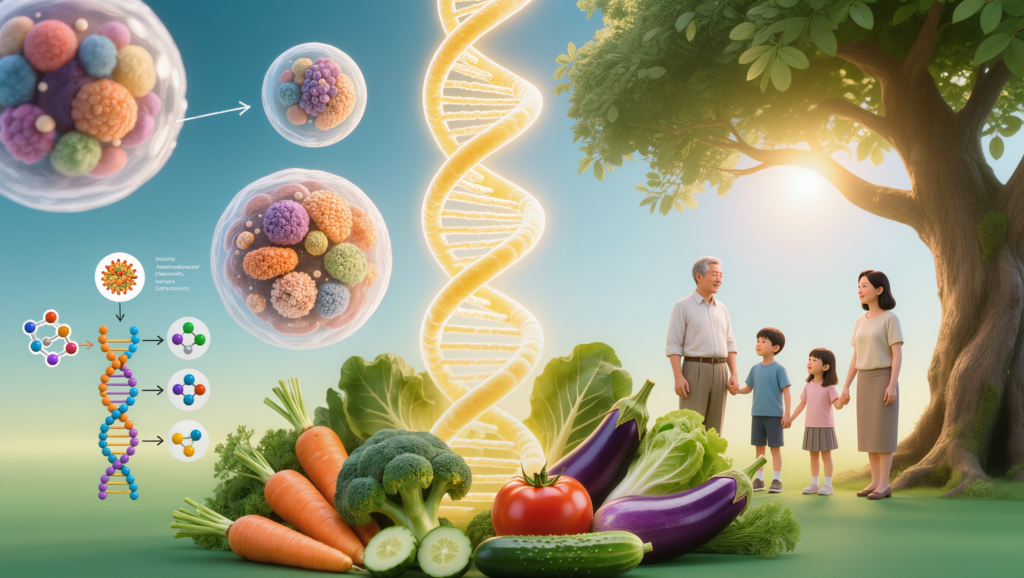Epigenetics sounds like a buzzword, but it’s really a hopeful message written into your biology: your genes are not your destiny. What you eat, breathe, and are exposed to can literally dial genes up or down—affecting your risk of disease, how you age, and even aspects of your children’s and grandchildren’s health. When you zoom in on food, a big question emerges: can choosing organic actually “reprogram” your family’s health future through epigenetics?
Short answer: there’s growing evidence that cleaner, nutrient-dense, pesticide-light diets—including organic patterns—can tilt epigenetic switches in a healthier direction, while chronic exposure to synthetic pesticides and ultra-processed foods can push them the other way.
Below is a deep, but practical, guide to the science—and what it really means for your grocery cart.
Epigenetics 101: How Your Life Talks to Your Genes
Epigenetics refers to chemical tags and structural changes that sit on top of your DNA (like software on your hardware) and influence whether genes are turned “on,” “off,” or somewhere in between.
Main mechanisms include:
- DNA methylation: Tiny methyl groups attach to DNA, usually silencing or dampening gene activity.
- Histone modification: Proteins called histones act like spools for DNA; adding or removing chemical tags makes genes more or less accessible.
- Non‑coding RNAs: Small RNA molecules fine‑tune how genes are read and translated.
These changes do not alter the DNA sequence itself, but they can profoundly affect metabolism, immunity, brain development, and disease risk.
Crucially, epigenetic marks are:
- Dynamic – they respond to nutrition, toxins, stress, sleep, exercise.
- Sometimes heritable – especially around conception and pregnancy, some marks can be passed to the next generation.
That’s where organic eating enters the picture.
Diet and Epigenetics: Why Food Is Information, Not Just Fuel
Your body uses nutrients not only as calories and building blocks, but also as epigenetic signals.
Examples:
- Folate, choline, B12, and methionine donate methyl groups for DNA methylation.
- Polyphenols in berries, green tea, turmeric, and cocoa can inhibit or activate enzymes that write or erase epigenetic marks.
- Short‑chain fatty acids from fermentable fiber (like butyrate) can modify histones and influence inflammation, immunity, and gut barrier function.
A 2022 review in Nutrients highlighted that healthy patterns rich in whole plant foods, omega‑3 fats, and micronutrients are consistently linked to beneficial epigenetic profiles—such as improved insulin sensitivity, less chronic inflammation, and better cardiometabolic health.
Meanwhile, diets high in ultra‑processed foods, added sugars, and industrial fats are associated with epigenetic signatures tied to obesity, fatty liver, and cardiovascular disease.
Maternal & Early-Life Nutrition: Programming the Next Generation
Pregnancy, breastfeeding, and early childhood are “epigenetic hot zones” when the developing epigenome is especially sensitive to diet and environment.
Major findings:
- A comprehensive review in Nutrients found that maternal diets low in key methyl‑donor nutrients (folate, B12, choline) or high in excess calories/fats can alter DNA methylation in the fetus’s liver, brain, and metabolic tissues—affecting lifelong obesity, diabetes, and cardiovascular risk.
- The maternal gut microbiome and its metabolites (especially SCFAs) also communicate with the fetal epigenome, linking mom’s fiber and plant-food intake to offspring inflammation and immune programming.
- Animal studies show that maternal exposure to endocrine‑disrupting chemicals and pesticides can cause epigenetic changes that persist for several generations, even when later generations are not directly exposed.
So the question becomes: does choosing organic meaningfully change this exposure picture?
Pesticides, Epigenetics, and Why Organic Matters
Organic agriculture prohibits synthetic pesticides, many of which are known or suspected endocrine disruptors. Those compounds can bind hormone receptors, increase oxidative stress, and alter epigenetic enzymes (DNA methyltransferases, histone modifiers).
Key evidence:
- A 2022 review on epigenetic inheritance and pesticides concluded that multiple pesticide classes—including organophosphates and organochlorines—can induce lasting DNA methylation changes in genes related to neurodevelopment, metabolism, and reproduction in both humans and animals.
- Experimental models show that prenatal pesticide exposure can lead to epimutations in sperm and eggs that transmit increased risk of obesity, kidney disease, and reproductive problems to grandchildren, even when only the first generation was exposed.
- Some pesticides have been shown to interfere with one‑carbon metabolism (the folate–methylation pathway), effectively “hijacking” the same machinery your body uses for healthy epigenetic programming.
On the flip side, several intervention studies have shown that switching to an organic diet can dramatically reduce urinary pesticide metabolites in both adults and children—often within days.
An analysis reported by Beyond Pesticides in 2025 summarized that participants who swapped from conventional to predominantly organic diets showed significant drops in biomarkers of organophosphate and pyrethroid exposure, supporting organic as a practical route to lower toxic burden.
Lower chemical burden = less epigenetic disruption pressure on the system, especially in kids whose detox pathways and epigenomes are still developing.
“Epigenetic Diet” vs. “Organic Diet”: Where They Overlap
An “epigenetic diet” is a term used by researchers to describe eating patterns rich in compounds known to modulate gene expression in a protective way. Common denominators:
- Colorful fruits and vegetables (polyphenols, carotenoids, vitamin C)
- Cruciferous vegetables (sulforaphane, indoles)
- Herbs and spices (curcumin, rosemary, garlic compounds)
- Fermented foods and fiber (SCFAs, microbiome–epigenome crosstalk)
- Whole, minimally processed foods
Organic eating doesn’t guarantee all of that, but it does two important things:
- Reduces epigenetically disruptive exposures (pesticides, some additives).
- Is strongly correlated with a more whole-food, plant-rich diet, which tends to naturally contain more epigenetically active beneficial compounds.
Several observational cohorts find that people who prioritize organic foods also eat more fiber, vegetables, and minimally processed grains—exactly the pattern linked to healthier epigenetic signatures.
Gut Microbiome, Epigenetics, and Organic Food
Your gut microbes are part of your epigenetic story. They convert dietary fibers and polyphenols into bioactive metabolites that can influence gene expression in the gut, liver, brain, and immune cells.
- SCFAs like butyrate can inhibit histone deacetylases (HDACs), a class of enzymes that tighten DNA around histones; this can reduce inflammation and support regulatory immune pathways.
- Microbial metabolites can cross the placenta and are thought to help shape fetal immune and metabolic programming.
Why organic may support this:
- Lower pesticide exposure appears to preserve microbial diversity and beneficial strains, whereas some common pesticides and herbicides are linked to dysbiosis in experimental models.
- Organic systems often emphasize soil health and microbial richness—early data suggest this may translate to different microbial signatures on produce and possibly to consumers, though this area is still emerging.
In simple terms: a diverse, minimally contaminated microbiome feeds into a healthier epigenetic landscape.
Can Organic Eating Really “Reprogram” Your Family’s Health?
“Reprogram” is a big word, but there are several realistic, science‑based ways organic and epigenetic‑smart eating can shift your family’s trajectory:
- Reducing inherited risk expression
- You can’t change genes you’ve passed on, but you can modify how strongly many of them are expressed through nutrition, toxin load, and lifestyle.
- Protecting the next generation’s epigenome
- Preconception and pregnancy diets rich in whole, largely organic foods support optimal methylation patterns, healthier birth weights, and lower lifelong risk of metabolic disease for children.
- Reducing maternal pesticide exposure decreases the chance of passing along harmful epimutations.
- Altering disease susceptibility later in life
- Epigenetic marks remain somewhat plastic throughout life; shifting to a more organic, nutrient‑dense pattern can gradually modify methylation profiles associated with inflammation, oxidative stress, and metabolic disease.
- Stacking small advantages over time
- No single salad or organic apple flips a genetic switch overnight. But thousands of meals over years, especially during critical windows (preconception, pregnancy, childhood, puberty), add up to meaningful differences in epigenetic risk profiles.
Practical Ways to “Eat Epigenetic” (and More Organic) as a Family
You don’t need perfection or a 100% organic kitchen to tap into these benefits. Focus on leverage points:
1. Prioritize Organic for “Dirty” and High‑Impact Items
When budget is limited, prioritize organic for:
- Thin‑skinned fruits and leafy greens (berries, apples, spinach, lettuce)
- Children’s staple foods (milk/yogurt, oats, applesauce, baby snacks)
- Oils and animal products, where fat can store lipophilic contaminants
This gives you the biggest reduction in pesticide exposure per euro/dollar spent.
2. Load Up on Epigenetic “Signal” Foods
Aim to feature daily:
- Dark leafy greens, crucifers (broccoli, kale, cabbage)
- Berries and colorful fruits
- Herbs and spices (turmeric, garlic, rosemary, oregano)
- Fermented foods (yogurt, kefir, kimchi, sauerkraut)
- Fiber‑rich legumes and whole grains
These provide methyl donors, polyphenols, and microbiome‑shaping fibers that support a healthy epigenome.
3. Protect Preconception and Pregnancy Windows
For aspiring or expecting parents:
- Emphasize organic, folate‑rich greens; choline sources (eggs, legumes); omega‑3s; and fermented foods.
- Minimize ultra‑processed foods, pesticide‑heavy produce, and unnecessary exposures (like lawn chemicals, some home pesticides).
The return-on-investment for epigenetic health in these windows is huge.
4. Involve Kids Early
- Let children help wash, chop, and cook organic produce.
- Teach them that “food talks to your genes” in age‑appropriate language.
- Make organic and whole foods the default at home so their “normal” is epigenetically supportive rather than disruptive.
The Limits of the Evidence (And What We Still Don’t Know)
It’s important to stay honest:
- We don’t yet have large, decades‑long, randomized trials directly proving that organic diets improve human epigenetic profiles and disease outcomes across generations—those are incredibly hard to run.
- Much of the mechanistic data comes from animal models, cell culture, and smaller human cohorts.
What we do have is a convergence of evidence:
- Diet clearly influences epigenetics and disease risk.
- Maternal and early‑life nutrition shape offspring epigenomes.
- Pesticides and endocrine disruptors can cause harmful epigenetic changes, some of which may be passed down.
- Organic patterns meaningfully reduce those exposures and are strongly associated with more whole, plant‑rich, epigenetically beneficial eating patterns.
Taken together, it’s reasonable—not hype—to see organic, epigenetic‑smart eating as a strategic way to tilt your family’s health odds in your favor. If genes load the gun and environment pulls the trigger, then each organic, whole‑food meal is one more moment you choose not to pull it—and maybe even to gently bend the barrel in a healthier direction for your entire family’s future.








